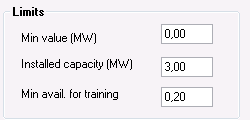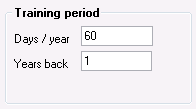
The Quarantine setting can be both positive and negative. Thus, a value 0 doesn’t turn the quarantine completely off, but merely sets the end of reliable data to the same as the forecast start date. In order to be able to use the real-time correction, a negative value must be specified. If for example a forecast is made that starts 2016-01-01 and has quarantine hours setting set to -12. In that case all values in the time series data after 1016-01-01 12:00 will be ignored.

The minimum value and installed maximum capacity is specified below in the ”Limits” control. The forecast values are bound within these limits. Also, historical data outside these bounds are ignored during the model estimation process. The “Min aval. for training” sets a threshold, so that data for periods when the availability as a fraction of the installed capacity is less than this threshold will be ignored.

Specify the hub height, rotor diameter as metadata used when interpolating the wind speed values.
The empirical power curves are piecewise defined.
•Between “Upper cut-in speed” and “Lower cut-out speed”, the power curves will follow an S-shaped curve which is estimated by a non-linear regression.
•For wind speeds below the “ Lower cut-in speed”, the forecasted production will be zero.
•Between “ Lower cut-in speed” and “Upper cut-in speed”, the power curve will increase linearly from zero up to the estimated S-curve.
•Similarly, between “Lower cut-out speed” and “Upper cut-out speed”, the curve will decrease down to zero again.

By using data from several years from the same season, Zephyros can adjust for seasonal bias in the weather forecasts. Specify the number of days and years back in the training period in the “Training period”-box below.

The nonlinear regression uses the iterative Levenberg-Marquardt minimization. “Max iterations” specifies the maximum number of iterations, “Epsilon, g,f,x” sets the stopping criteria for the Levenberg-Marquardt process (See more explanations in the forecast log files). If “Estimate optimal number of wind direction sectors” is checked, the program will automatically select the optimal number of wind direction sectors from 1 to “(Max) Wind sectors:”, otherwise the program will use “(Max) Wind sectors:” number of wind direction sectors. The trim factor specifies the fraction from 0 to 1 of extreme values that should be ignored in the trimmed regression described in the previous section.
